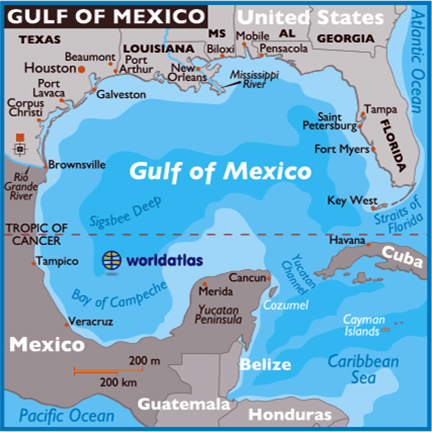Red Tide | 04 Aug 2021
Why in News
Florida has been battling outbreaks of red tide, caused by the algae Karenia brevis, for several years.
- This year's bloom may have been aggravated due to the release of contaminated water into Tampa Bay earlier.
- Tampa Bay, arm of the Gulf of Mexico, indenting the west coast of Florida, US.
Key Points
- About:
- Harmful Algal Blooms, or HABs, occur when colonies of algae grow out of control and produce toxic or harmful effects on people, fish, shellfish, marine mammals and birds.
- While many people call these blooms 'red tides,' scientists prefer the term harmful algal bloom.
- One of the best known HABs in the US occurs nearly every summer along Florida’s Gulf Coast.
- This type of bloom is caused by a species of dinoflagellate known as Karenia brevis.
- On the other hand, blooms in freshwater lakes and reservoirs are most commonly caused by blue-green algae (also known as cyanobacteria).
- Blue-green algae blooms have a direct relation to agricultural and urban runoff. Nutrient pollution encourages the growth of cyanobacteria.
- Causes of Algal Blooms:
- Eutrophication:
- Nutrients promote and support the growth of algae and Cyanobacteria. The Eutrophication (nutrient enrichment) of waterways is considered as a major factor.
- Temperature:
- Blooms are more likely to happen in summer or fall but can occur any time of year.
- Turbidity:
- Turbidity is caused by the presence of suspended particles and organic matter in the water column.
- When turbidity is low, more light can penetrate through the water column. This creates optimal conditions for algal growth.
- Eutrophication:
- Implications of Algal Bloom:
- Produce extremely dangerous toxins that can sicken or kill people and animals.
- Fish contaminated with the algae and eaten by other organisms, including humans, can be harmful to them.
- Algal blooms can also impact aquaculture, or the farming of marine life.
- There have also been complaints of respiratory distress in humans due to red tide.
- Algal Blooms deprive aquatic organisms of Sunlight and oxygen and negatively impact a variety of species that live below the water surface.
- Create Dead Zones in the water.
- "Dead zone" is a more common term for hypoxia, which refers to a reduced level of oxygen in the water.
- Raise treatment costs for drinking water. Hurt industries that depend on clean water.
- Produce extremely dangerous toxins that can sicken or kill people and animals.
- Mitigating Risks from HAB:
- Multiple treatment of effluent:
- Simple treatment options are not effective; multiple treatment steps are typically needed to remove algae toxins.
- Using tertiary sewage treatment methods to remove phosphate and nitrate before discharging the effluent into rivers and lakes.
- Nitrogen testing & modelling:
- N-Testing is a technique to find the optimum amount of fertilizer required for crop plants. It will reduce the amount of nitrogen lost to the surrounding area.
- Encouraging organic farming:
- Reducing the overuse of fertilizers in agriculture and encouraging organic farming can reduce the bulk flow of runoff and can be effective for reducing severe algal blooms.
- Reduction in nitrogen emission from vehicles and power plants.
- Reducing the use of phosphates as builders in detergents.
- Multiple treatment of effluent:
- Measures to cope with Algal Bloom in India:
- Algal Bloom Information Service: ABIS provides timely information on harmful algal blooms, which are detrimental to coastal fisheries, water quality and also tend to induce respiratory problems within the coastal population from time to time.
- ISRO’s Oceansat-2 satellite launched in 2009 can cover larger areas and provide global ocean colour.

